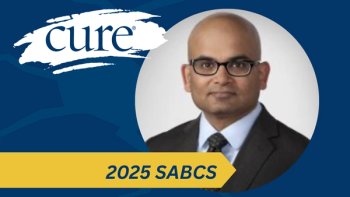
Another Year of Lung Cancer Advancements Expected in 2017
2016 was an exciting year for non-small cell lung cancer, and more advances are expected for 2017.
Things are looking up for lung cancer care for the year 2017, especially following the exciting advances last year in treating non-small cell lung cancer (NSCLC) in 2016.
In October 2016, the FDA approved Keytruda (pembrolizumab) for the frontline treatment of patients with metastatic NSCLC whose tumors have more than 50 percent PD-L1 expression. The agent was previously approved for second-line NSCLC.
Also in October 2016, the FDA approved Tecentriq (atezolizumab) for the treatment of patients with metastatic NSCLC who have progressed after a platinum-containing regimen and an FDA-approved targeted therapy for those patients harboring EGFR or ALK abnormalities.
Opdivo (nivolumab), which is approved by the FDA in second-line NSCLC, had negative first-line NSCLC results from the CheckMate-026 trial reported in October 2016 at the annual ESMO Congress. However, researchers have noted issues that contributed to the negative findings, including the PD-L1 expression inclusion criteria used in the study.
What are some exciting advancements in lung cancer we have witnessed over the last year?
In a recent interview with CURE, Joel Neal, M.D., Ph.D., assistant professor of Medicine (Oncology), Stanford University Medical Center, discussed how recent immunotherapy advances are transitioning the field of NSCLC and how the impact of molecular testing continues to shape treatment decisions.The biggest thing that comes first to mind is immunotherapy. After a couple of years, we are getting a better understanding of how immunotherapy works, who it works for, and who we should use it in. However, we haven’t quite figured out who we shouldn’t use it in yet.
We are refining what our probability is that a given patient will respond to immunotherapy. There are three drugs that all have approval and a couple more waiting in the wings. The biggest questions are, who should we give it to in first line, who should we maybe wait for second line, and who should we wait for third line and beyond?
What are your thoughts on frontline PD-1 inhibitors in NSCLC? We saw in CheckMate-026 that Opdivo did not meet the PFS endpoint, but Keytruda does have approval in the frontline setting.
There are also some developments for targeted therapies. One of the big exciting stories for EGFR-mutant lung cancer was the T790M-active drug Tagrisso (osimertinib). Testing for T790M has become a very hot topic as that drug has become FDA approved, as well. Both agents use different assays for PD-L1 testing, and we saw data that not all of the PD-L1 tests are exactly the same. The IHC 28-8 PharmDx test, which is the diagnostic test for Opdivo, looks like it captures a wider group of positive people. The IHC 22C3 PharmDx test, which is the test for Keytruda, may be a little bit more selective. Then, the Ventana PD-L1 (SP142) test for Tecentriq …looked like it had the fewest positives out of anyone. All of these tests are accepting in different positive groups, plus there are different cutoffs for each of the drugs.
Beyond frontline, what do you recommend for second-line treatment?
I’m not convinced that the differences between Keytruda and Opdivo led to the differences in the trial, so much that the differences are in testing and selecting different groups of patients. The patients with the tumors that express the highest level of PD-L1, are going to be the ones most likely to respond—and the frontline setting makes sense. When we see response rates of 30 percent, 40 percent, and 50 percent, those rival what we see from platinum chemotherapy doublets. But, when we see response rates of 10 percent, 20 percent, or less than 10 percent for EGFR-mutant patients, then we think, “Wait until second- or third-line.” It’s mainly a PD-L1 testing issue that has to be figured out. Opdivo is approved for all second-line patients without any testing diagnostics, so that is the more commonly used drug, I suspect. I am increasingly doing the IHC 22C3 PharmDx Keytruda test for patients. If I have a few weeks to decide and determine my level of enthusiasm of whether I should go with the anti—PD-1 agent or more standard cytotoxic chemotherapy, then I’ll do the test in advance and figure out the probability of response.
Do you envision there being more combinations with immunotherapy or immunotherapy with chemotherapy?
For the 0 percent PD-L1—positive patients, you could make an argument that second-line chemotherapy or third-line single-agent chemotherapy is as good—not worse. Immunotherapy can be combined with almost everything: chemotherapy, radiation therapy, targeted therapy and, most excitedly, are other immunotherapies. We are trying to figure out how to make immunotherapy work for more patients and work for a longer time. We have a number of trials open in the combination immunotherapy realm.
There has been much progress made in the last couple of years. What does the future hold?
We are also exploring combinations with radiation and with chemotherapy. I am not convinced whether they are synergistic or we are increasing the response rates. This is because there’s a chance of response to chemotherapy and to immunotherapy alone, and then we would be adding those two together. We are going to further refine the question of which patients do we give anti­—PD-1/PD-L1 drugs to and in which line of therapy. We need to have a more standard algorithm in practice for that. Hopefully, we will find who we can give Yervoy (ipilimumab) and Opdivo to or other checkpoint inhibitors, other CTLA-4 combination therapies and then hopefully we will see some new breakthroughs—new drugs working together. These include vaccines, OX40 and IDO inhibitors; all of those have potential to be synergistic and really increase the response rates and duration of response for patients.
Are there any ongoing trials that you are involved in?
I tell my patients, “Right now, without any PD-L1 testing, it’s like rolling a six-sided die. If it comes up on your favorite number it works but, really, there is a [one] of six chance in unselected patients that these drugs will work. And, that’s just not good enough.” We have EGFR inhibitors looking to overcome acquired resistance. At Stanford Medicine, we have a lot of patients with EGFR-mutant NSCLC who are always looking for new lines of therapy after other things haven’t worked. We have seen a couple of new ALK inhibitors, but overcoming acquired resistance for our ALK-positive patients is important, too.
Beyond the PD-1/PD-L1 immunotherapy, we are opening and looking toward the T-cell transgenic therapy trials, such as cellular therapy trials. At Stanford Medicine, we are opening new cellular therapy trials to reengineer patients with these T cells to try and fight the cancer in a way they may not have otherwise.
What is the importance of molecular testing, especially going forward in the field?
The PD-1/PD-L1 drugs basically break down a shield that the tumor put up around it. However, if we can teach the T cell to fight the tumor if it didn’t want to in the first place, that’s exciting. We test all first-line patients for EGFR, ALK and ROS1. Those results come back within one to two weeks, and then we also do a next-generation sequencing (NGS) test. Then, we also do a slower NGS test. However, NGS takes four weeks or so for turnaround time and, the faster you have a frontline decision, the better. Patients are nervous, even for one and a half weeks, and I could never wait four weeks to decide on the EGFR tests. Frontline will do all of those and, in the community setting, it may be a little too much. You could certainly wait for NGS for second-line treatment; that is very reasonable, too.
For acquired resistance, it’s important to do a repeat biopsy. Increasingly, we are using the blood-repeat biopsies first and looking for acquired resistance for EGFR-mutant lung cancer—looking for the T790M mutation, and also repeat biopsy of tissue.
We learn a lot from the repeat biopsy of tissue. All of the academics want to repeat biopsy at acquired resistance. You have to recognize it when there is a really good response, and then the tumor grows. In some patients, the tumor just grows right off the bat on EGFR or ALK inhibitors, and usually we don’t find the resistant mutations in those patients.




